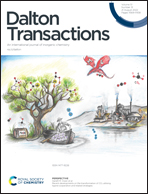Selective detection of sulfasalazine antibiotic and its controllable photodegradation into 5-aminosalicylic acid by visible-light-responsive metal–organic framework†
Abstract
The extensive use of sulfasalazine (SSZ) antibiotics has brought potential threats to aquatic ecosystems and human health. Thus, necessary measures for the removal of SSZ must be taken to prevent arbitrary antibiotic exposure to the aquatic environment. However, not all the recent photocatalysts that have been used for the degradation of SSZ could not achieve the controlled release of SSZ and hence are losing their medicinal values. Herein, by utilizing an Eosin Y moiety as an efficient light-harvesting and emission site, an Eosin Y-based visible-light-responsive metal–organic framework has been synthesized and characterized, which exhibits high selectivity for detecting the antibiotic SSZ in water and simulated physiological conditions, with a detection limit of below 1 μM (0.4 μg mL−1). It also represents the first example of a MOF-based photocatalyst for the controllable degradation of SSZ into 5-aminosalicylic acid with excellent catalytic activity and recyclability.



 Please wait while we load your content...
Please wait while we load your content...